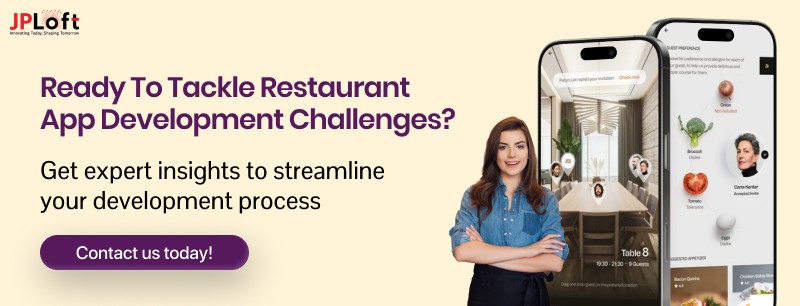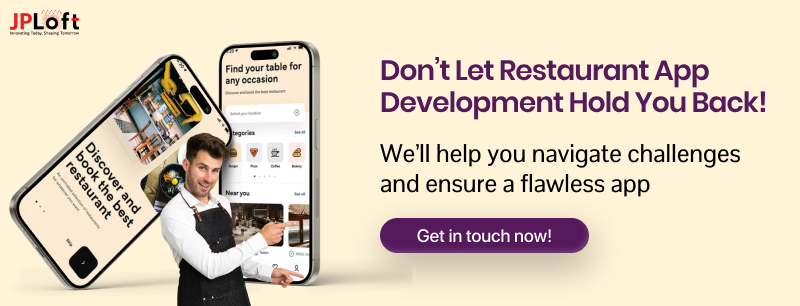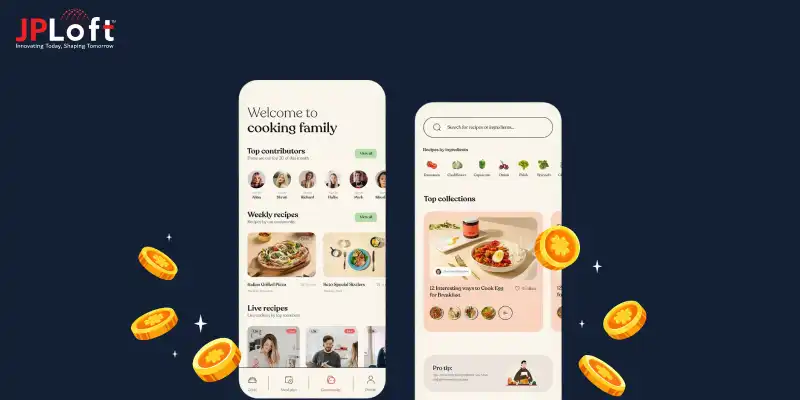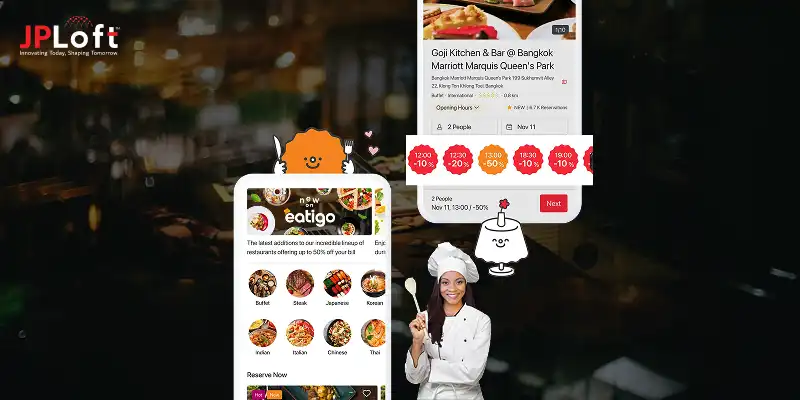On one side, developing a restaurant app has become a key component for modern-day dining experiences; on the other hand, creating a successful app for the foodservice industry comes with its own set of challenges.
Designing a seamless user interface comes with its own set of challenges.
From designing a seamless user interface to integrating complex functionalities like online ordering and reservation, the process requires careful planning with proper execution.
Whether you're a startup or an established restaurant, understanding the early challenges of restaurant apps is important to avoid setbacks and ensure long-term success.
In this article, we’ll delve into the most common restaurant app development challenges, explore effective solutions, and support them with relevant market statistics.
Latest Stats on Restaurant App
In recent years, rapid technological advancements have transformed the way we shop, with significant growth reflected in market statistics.
Online delivery apps, especially restaurant apps, have seen a massive surge in popularity as users move away from traditional dining habits and increasingly prefer ordering food online, enjoying a wide variety of cuisines from different regions at their fingertips.
-
- The global restaurant digitalization market is projected to reach USD 37.0 billion by 2033, up from USD 7.9 billion in 2023, demonstrating a compound annual growth rate (CAGR) of 16.7% during the forecast period from 2024 to 2033.
- 31% of customers use third-party delivery apps at least twice a week, highlighting the growing dependence on these platforms for meal convenience.
- 67% of online diners tend to visit restaurants with digital ordering options more often, emphasizing the role of digital tools in boosting customer loyalty.
- North America dominated the restaurant digitalization market, capturing over 37.5% of the global share.
Now that we've seen the significant growth of restaurant delivery apps.
Let’s explore some of the top restaurant app development challenges commonly faced during the development process.
Top 10 Challenges of Restaurant App Development & Their Solutions
Ever thought about “what are some key challenges while developing a restaurant app?
While the end product may look sleek and user-friendly, the development journey is filled with complexities.
Let’s take a closer look at some key points to consider.
1. User-Friendly Interface Design
One of the main challenges in developing a restaurant app is designing an intuitive, user-friendly interface.
A cluttered or confusing layout can quickly frustrate users, resulting in poor engagement and high abandonment rates.
Creating a seamless and visually appealing user experience is essential to keep customers coming back.
A well-designed interface not only improves usability but also builds trust and brand loyalty over time.
Solution:
Focus on simplicity and clarity in design.
Use a minimalistic approach, ensuring that essential functions like menu browsing, ordering, and payment options are easily accessible.
When you develop a restaurant app, prioritize intuitive navigation to enhance user satisfaction and reduce friction throughout the customer journey.
Consistent design elements and clear calls to action can further guide users effortlessly through the app experience.
2. Integration with POS Systems
Seamlessly integrating the app with the restaurant’s existing Point of Sale (POS) system is crucial.
One of the common challenges while creating a restaurant app occurs due to compatibility issues between various POS software.
These integration hurdles can lead to data inconsistencies, delays in order processing, and difficulty in synchronizing inventory and sales data in real-time.
With various POS systems using different technologies, ensuring compatibility becomes a complex task that requires careful planning and expert technical solutions.
Solution:
Ensure the app supports a wide range of POS systems.
Create an app that integrates with APIs that will help to streamline the process and ensure real-time synchronization between orders placed through the app and the POS system.
This integration should allow seamless data flow, enabling automatic updates to inventory, order status, and payment processing.
Additionally, implementing cloud-based solutions can further enhance scalability, ensuring the system remains reliable and accessible, even during peak hours.
By focusing on a smooth integration process, restaurants can improve efficiency, reduce errors, and enhance overall customer satisfaction.
3. Handling High Traffic During Peak Hours
Restaurants often experience spikes in traffic during peak hours, such as lunch and dinner times.
A critical restaurant app development challenge is ensuring the app’s backend infrastructure is scalable and robust enough to support high volumes of concurrent users.
The app must be able to handle these surges in traffic without crashing or slowing down, as any lag can lead to poor user experiences and lost orders.
Failure to address this can result in negative reviews, customer churn, and damage to the restaurant's reputation.
Solution:
Opt for cloud-based infrastructure and ensure the app is optimized for scalability to handle sudden surges in user activity.
One of the key challenges of restaurant apps is to work with content delivery networks (CDNs) that can also maintain performance during high traffic, distribute the load efficiently across the servers, and reduce latency.
Additionally, implementing performance monitoring tools that can help identify bottlenecks in real time, allowing developers to take quick action before users are affected.
Regular testing and server-side optimization are also essential to ensure the app remains responsive and reliable, even during peak hours or promotional events.
4. Real-Time Updates and Notifications
Keeping users informed about their order status, promotions, and availability of menu items can be a logistical nightmare without having a notification system in mobile apps.
One of the key challenges of mobile restaurant app development is implementing an effective notification system that balances timely updates without overwhelming the user.
A well-integrated system ensures timely communication through push notifications, SMS, or in-app alerts, which not only improves user satisfaction but also helps to reduce order-related enquiries.
Additionally, personalized notifications based on user preferences and behaviour can drive engagement and boost repeat purchases.
Solution:
Integrate push notifications to keep customers updated about their order status, special discounts, or changes in menu items.
Some of the best restaurant apps use this technique to keep their customers engaged with their apps.
Timely and relevant notifications help create a seamless user experience by reducing uncertainty and keeping customers informed every step of the way.
This solution also serves as a powerful marketing tool, allowing the restaurants to promote new menu items, announce limited-time deals, and re-engage inactive users.
5. Secure Payment Gateways
Payment security is a top priority for any app, especially in the restaurant industry, where users frequently make transactions for food orders.
Ensuring secure and seamless payment processing helps build customer trust and protects sensitive financial information from potential threats.
Integrating with reliable gateways, encrypting user data, and complying with industry standards like PCI DSS are essential steps in safeguarding transactions.
A critical aspect of the challenges of restaurant app development lies in balancing advanced security measures with a smooth and intuitive user experience during checkout.
As mobile payments continue to rise, addressing these security concerns is key to earning customer confidence and driving long-term loyalty.
Solution:
Implement SSL encryption and secure payment gateways like Stripe or PayPal to protect sensitive customer information during transactions.
Compliance with PCI-DSS standards is essential for maintaining customer trust and ensuring data protection.
App security plays a crucial role in safeguarding both user credentials and payment details from potential breaches or cyberattacks.
Regular security audits, tokenization, and multi-factor authentication can further strengthen the app’s defence against evolving threats.
6. User Feedback and Reviews Management
Collecting, managing, and acting on customer feedback can be difficult, especially when dealing with negative reviews, spam, or inconsistent input across different platforms.
Effectively filtering valuable insights from irrelevant or harmful content requires advanced moderation tools and thoughtful user experience design.
Among the many restaurant app development challenges, building a reliable and user-friendly feedback system that encourages honest responses while minimizing abuse is essential.
When handled well, customer feedback becomes a powerful tool for continuous improvement, helping restaurants enhance service quality and overall app performance.
Solution:
To overcome such challenges in restaurant apps, you should be effectively managing user-generated content while maintaining a positive and trustworthy environment.
Incorporate a comprehensive review management system that allows customers to rate individual dishes, delivery experience, and overall service quality.
This not only helps future users make informed decisions but also provides valuable insights to restaurants to improve further.
Additionally, enabling restaurants to respond to reviews, both positive and negative, fosters transparency and builds customer relationships.
Over time, a well-managed review system can significantly enhance user engagement, brand reputation, and customer loyalty.
7. Accurate Order Tracking
In today’s competitive market, meeting this expectation is not just a feature; it's a necessity for customer retention and satisfaction.
Some of the common challenges of mobile restaurant app development are offering proper information to users, as the live delivery system is crucial for transparency.
Users expect real-time updates on the status of their food order, and delays or inaccuracies in tracking can lead to dissatisfaction.
To address this, integrating GPS-enabled tracking and automated status notifications can significantly enhance the delivery experience and build user trust.
Solution:
Implementing features such as real-time order tracking through GPS and third-party services enhances the customer experience.
Establishing a transparent communication channel between users and restaurants helps ensure customers feel informed and confident about their orders.
Integrating GPS tracking for a delivery system can certainly increase the cost to create an app.
However, the investment often pays off by significantly improving user satisfaction, reducing order-related enquiries, and building customer trust.
8. Seamless Multi-Platform Experience
Customers now expect a consistent and seamless experience across all devices, including smartphones, tablets, and desktop computers.
Developing an app that performs equally well on both iOS and Android platforms comes with different challenges from restaurant apps.
Ensuring responsive design, platform-specific optimization, and smooth functionality across all devices is essential for delivering a high-quality user experience.
Failure to meet these expectations can lead to user frustration, reduced engagement, and ultimately, loss of customer loyalty.
Solution:
Opt for cross-platform development frameworks like Flutter or React Native, which ensure consistent user experiences across different platforms.
Regular testing and updates are necessary to maintain compatibility and performance.
Choosing such frameworks can also help reduce the overall cost to develop a restaurant app, as they allow developers to write a single codebase for multiple platforms, saving both time and resources.
Additionally, faster development cycles and easier maintenance make cross-platform solutions ideal for startups and businesses looking to launch quickly and efficiently.
9. Personalization and Customer Retention
Restaurants need to offer a personalized experience to stand out from competitors in an increasingly crowded digital marketplace.
Tailoring content such as menus, recommendations with loyalty rewards, and special deals based on individual user preferences can significantly boost engagement with customer satisfaction.
A major factor in restaurant app development challenges is building a robust personalization engine that can analyze user behaviour, order history, and preferences while maintaining app performance and data privacy.
Without the ability to customize menus or offer targeted promotions, retention rates can't be increased, and users may turn to competitors' apps.
Solution:
Leverage machine learning algorithms to analyze user behaviour, preferences, and purchase history for deeper customer insights.
This data-driven approach enables restaurants to deliver highly personalized recommendations, tailored loyalty rewards, and targeted promotions.
Such personalization not only enhances the user experience but also fosters stronger brand loyalty and significantly increases the likelihood of repeat business.
Over time, these strategies can lead to improved customer retention, higher engagement rates, and a competitive edge in the crowded food delivery market.
10. Data Privacy and Compliance
With customer data being collected for order history, preferences, and payment details, ensuring data privacy and complying with local regulations such as GDPR, CCPA, or other regional data protection laws is an absolute necessity.
Failure to do so can lead to legal consequences, financial penalties, and a loss of customer trust.
Restaurants and app developers must implement robust data encryption, secure storage practices, and transparent privacy policies to protect user information.
Addressing data protection and regulatory compliance is one of the most critical restaurant app challenges, requiring a thoughtful and proactive approach to user data management.
Solution:
Follow best practices in data encryption, user consent, and privacy policies to ensure that sensitive customer information is protected at every touchpoint.
Regular audits and compliance checks should be conducted to avoid any potential legal issues and to build long-term customer trust.
It's also essential to stay updated with evolving data protection regulations and adapt security measures accordingly.
Partnering with the best mobile app development company can help ensure that your app is built with industry-leading security standards, robust architecture, and full regulatory compliance from the ground up.
Investing in data privacy not only safeguards your business but also strengthens your brand’s reputation in the market.
How Can JPLoft Help You Overcome These Challenges?
JPLoft is a trusted team of experts with years of experience in creating high-performing restaurant apps tailored to meet each client's unique needs.
Whether you're facing challenges with data privacy compliance, cross-platform compatibility, or personalized user experiences, JPLoft offers reliable solutions backed by proven expertise.
The team utilizes advanced technologies such as AI, machine learning, and GPS integration to develop powerful, scalable apps that drive customer engagement and support long-term business growth.
As a leading restaurant app development company, JPLoft ensures your app complies with industry standards such as GDPR and PCI-DSS while also delivering a seamless and user-friendly interface that enhances the overall customer experience.
With a focus on continuous support, regular updates, and scalable architecture, the company helps you stay ahead of evolving customer expectations and market trends.
Partner with JPLoft to turn your restaurant app challenges into growth opportunities.
Conclusion
Building a successful restaurant app involves navigating a range of technical and strategic challenges, from ensuring real-time order tracking and secure payment processing to maintaining cross-platform compatibility and delivering personalized user experiences.
With growing customer expectations and intense market competition, addressing these challenges is vital for long-term success.
Choosing the right development strategy, technology stack, and feature set plays a crucial role in achieving a seamless, user-friendly, and secure application.
Whether you're launching a new app or upgrading an existing one, a thoughtful, well-executed approach can position your restaurant for sustained digital success.
By investing in quality development and continuous improvement, businesses can stay competitive in the market, build customer loyalty, and thrive in this ever-evolving industry.
FAQs
Challenges while developing a restaurant app include real-time order syncing, secure payments, GPS accuracy, scalability during peak hours, user retention, data privacy, and maintaining a smooth, user-friendly interface.
Solve challenges by using scalable architecture, integrating reliable APIs, ensuring strong UX/UI design, prioritizing security, conducting thorough testing, and continuously updating the app based on user feedback and analytics.
Yes, most restaurant apps can be integrated with popular third-party delivery platforms such as Uber Eats, Grubhub, DoorDash, or Postmates.
These integrations are typically done via APIs and allow you to expand your delivery options.
Yes, multi-location support can be integrated into your app.
It allows users to select the nearest branch, view location-specific menus, and get accurate delivery estimates.
Customer reviews can be managed directly within the app through a review management system.
AI tools can also be used to moderate reviews, flagging inappropriate or spam content.
Yes, an admin panel is essential for managing menu items, pricing, customer data, orders, and promotions.
It allows restaurant owners and managers to easily update menus, track inventory, view sales reports, and manage customer reviews.













Share this blog